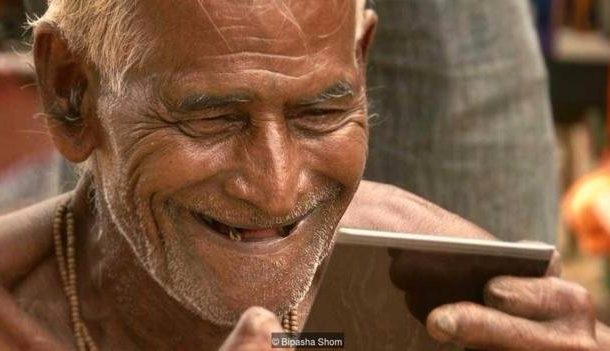A white-haired beggar sits outside the 13th-century Konark Sun Temple in Odisha, India, a wide smile spread across his face. His hands, deformed by leprosy, cradle the first photo of himself he has ever seen.
Swapna, a young mother in Kolkata, lives in a grass hut without electricity or running water. She has no photos of her wedding, but thanks to Hollywood film editor Bipasha Shom, she owns a portrait of herself and her five-month-old son, Neeladri.

This mother is seeing a photograph of her daugter for the first time
These two are among hundreds of impoverished Indians that Shom has gifted with a photograph. “Many of these people are surviving on a dollar a day or less, and a photo is a luxury item,” she said. “They do not have the means to buy cameras, let alone afford to make prints.” Some have cell phones but they are very basic models, with no photo capability or with extremely low resolution images.
Born in Kolkata, but raised in New Jersey, Shom, 47, was in her teens when she first began giving away photographs while visiting relatives in India. “It was something I knew how to do, so that is what I offered,” she said. “While photos were not high on the list of priorities, I felt that it was important for people to have a record of their lives. Imagine not having any photos of your wedding, your children, your parents.”

This was the first photo these three sisters had of themselves
Last December, Shom returned again to Kolkata, this time with her husband, Chris Manley, a cinematographer and director of photography for the TV series Mad Men, their two children and a photographer friend, Julie Black Nichols. They spent four weeks giving away hundreds of photos in Kolkata and the coastal town of Puri. While Shom photographed people of all ages, Manley and Black captured her subjects gazing in awe at their photos for the first time.
What made this trip unique was Shom’s use of instant photography. “I had been taking pictures using a SLR camera, then getting prints made and returning to the community to hand them out,” she said. “The process became so much easier with an instant camera. We could have gotten a wireless printer and done it that way, but there is a magical element to instant photography that I love. That moment when people see their image develop on a blank piece of film is priceless.”

Children are fascinated by their images developing on film
“It was incredible to see people's reactions to the photos,” Shom said. “We'd approach people who looked pretty intimidating and then watch as their faces just melted into huge smiles as they watched the photos develop. Mothers would ask us to take group photos with their kids. People would run into their homes and pull out their elderly grandparents so we could capture their only image.”

Children posing for pictures
Shom particularly enjoyed photographing children with the help of her daughter and son, Priya and Devan. “It was really powerful for them,” she said. “We take so much for granted in the US. We don’t realise how much we have and how luxurious our lives are.”
To keep the project going, Shom has founded a nonprofit,GivePhotos, and is raising money to buy cameras and film to ship to photographers in India and other interested countries.

Three schoolgirls getting their photo taken
While she has found the project rewarding, Shom admits she sometimes questions the value of giving photos to those who have so little. But then she quickly pointed out that it’s often family photos that people grab when fleeing a house fire.
“We realise that giving a photo is not like building a school or a hospital or feeding the hungry, but I think a photo is something that feeds the soul,” she said. “It’s hard to know how these images will impact people’s lives but I think we’ve brought some small amount of happiness.”
source:myjoyonline


Comments